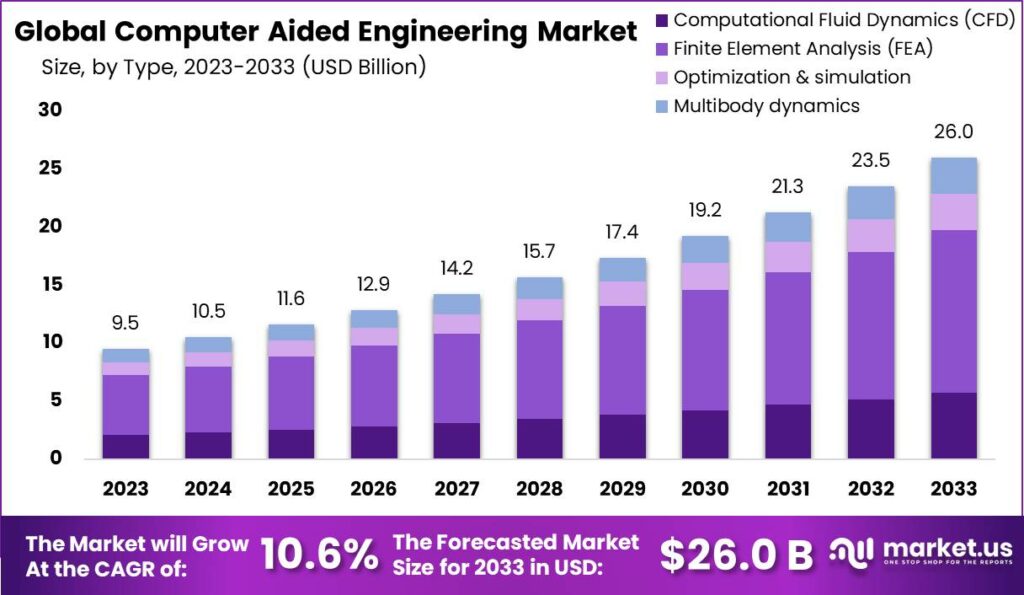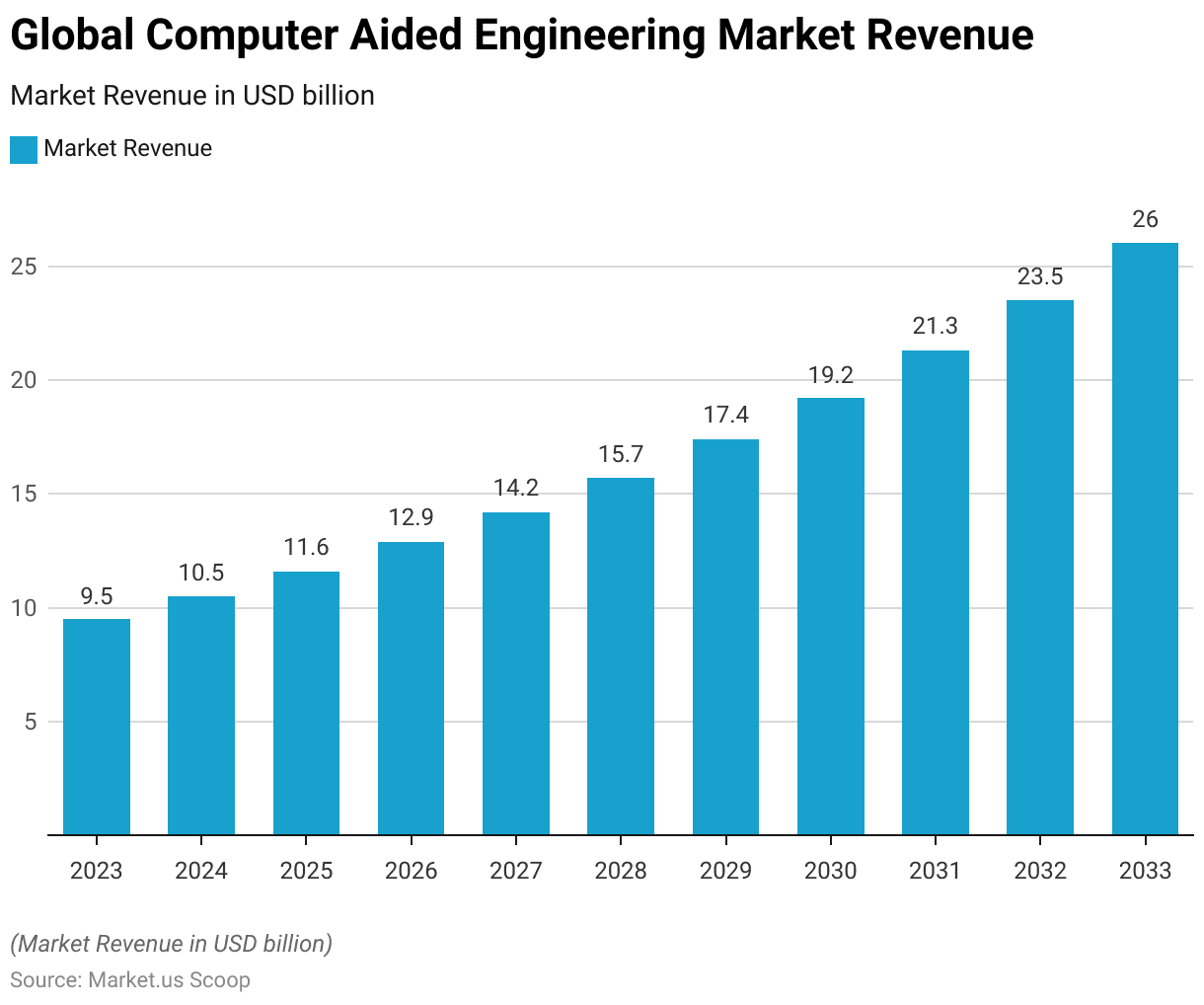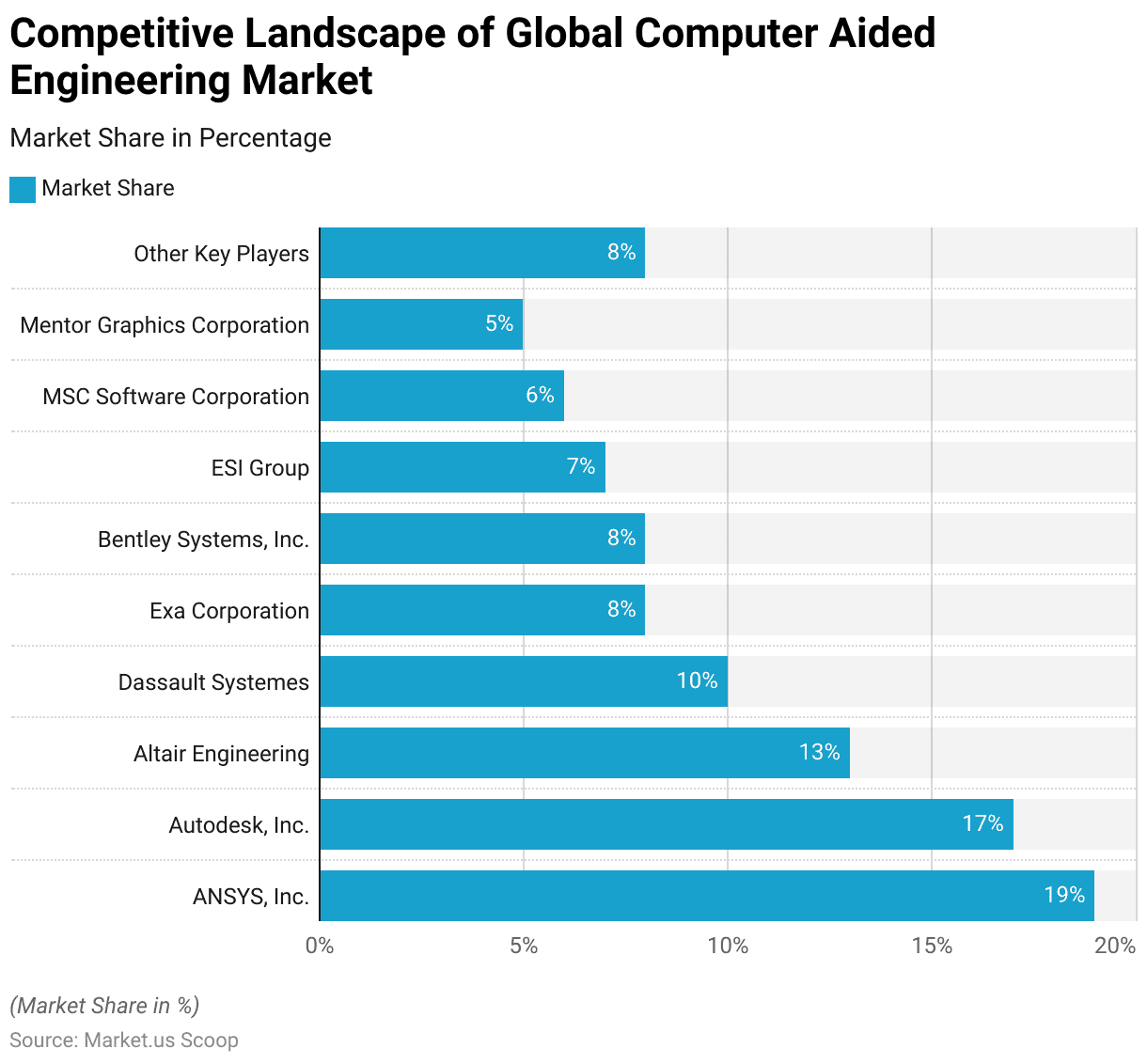Table of Contents
- Introduction
- Editor’s Choice
- Computer-Aided Engineering Market Overview
- History of Computer-Aided Engineering
- Technical Specifications of Computer-Aided Engineering Tools
- Design Process of Computer-Aided Engineering
- Applications of Computer-Aided Engineering in Different Industries
- Regulations for Computer-Aided Engineering
Introduction
According to Computer Aided Engineering Statistics, Computer Aided Engineering (CAE) utilizes specialized software to simulate, analyze, and optimize engineering designs before physical prototypes are made, thus reducing costs and time in the product development cycle.
It encompasses Finite Element Analysis (FEA), Computational Fluid Dynamics (CFD), and other techniques to model stress, fluid flow, heat transfer fluids, and more.
The process involves pre-processing CAD models, running simulations, and post-processing results to inform design decisions.
CAE benefits automotive, aerospace, and electronics industries by improving product quality, accelerating design cycles, and enabling innovative solutions.
Despite its advantages, CAE requires skilled implementation and accurate data inputs to ensure reliable outcomes.
Editor’s Choice
- In 2023, the computer-aided engineering (CAE) market revenue stood at USD 9.5 billion.
- The deployment model of the Computer-Aided Engineering (CAE) market is characterized by a significant preference for on-premise solutions, which currently hold a 61% market share.
- The Computer-Aided Engineering (CAE) market is dominated by several key players. ANSYS, Inc. leading the industry with a 19% market share.
- The global Computer-Aided Engineering (CAE) market demonstrates diverse regional distribution, with Europe leading the market with a 33.7% share.
- The history of Computer-Aided Engineering (CAE) tools dates back to the early development of numerical control systems in the 1950s. With significant milestones shaping its evolution.
- FEA, which commands over 54% of the CAE market. Simulates how products respond to real-world forces, vibrations, and other physical effects. Allowing engineers to optimize designs for strength and durability.
- In the United States, CAE practices are governed by strict industry standards and government regulations. Particularly in aerospace, automotive, and defense sectors, where accuracy and safety are paramount.

Computer-Aided Engineering Market Overview
Global Computer-Aided Engineering Market Size
- The global Computer-Aided Engineering (CAE) market has exhibited significant growth at a CAGR of 10.6% over the past few years and is projected to continue this upward trend.
- In 2023, the market revenue stood at USD 9.5 billion.
- By 2032, the market is projected to achieve USD 23.5 billion. Culminating in a substantial increase to USD 26.0 billion by 2033.

Global Computer-Aided Engineering Market Share – By Deployment Model
- The deployment model of the Computer-Aided Engineering (CAE) market is characterized by a significant preference for on-premise solutions, which currently hold a 61% market share.
- This dominance highlights the continued reliance on traditional, localized computing environments for CAE applications.
- Conversely, cloud-based solutions account for 39% of the market share. Reflecting a growing trend toward flexible, scalable, and remotely accessible CAE technologies.

Competitive Landscape of the Global Computer-Aided Engineering Market
- The Computer-Aided Engineering (CAE) market is dominated by several key players, with ANSYS, Inc. leading the industry with a 19% market share.
- Autodesk, Inc. follows closely with a 17% share, while Altair Engineering holds 13% of the market.
- Dassault Systèmes captures 10% of the market, and both Exa Corporation and Bentley Systems, Inc. each account for 8%.
- ESI Group has a 7% market share, and MSC Software Corporation and Mentor Graphics Corporation hold 6% and 5%, respectively.
- The remaining 8% of the market is comprised of other key players. Highlighting a competitive landscape with a mix of dominant and emerging companies in the CAE sector.

Regional Analysis of the Global Computer-Aided Engineering Market
- The global Computer-Aided Engineering (CAE) market demonstrates diverse regional distribution, with Europe leading the market with a 33.7% share.
- The Asia-Pacific (APAC) region follows, capturing 28.4% of the market, reflecting its growing industrial design and technological advancements.
- North America holds a significant 26.9% share, underscoring its robust technological infrastructure and high adoption rates of CAE solutions.
- South America accounts for 7.0% of the market, while the Middle East and Africa (MEA) region comprises 4.1%. Indicating emerging opportunities and potential for growth in these areas.

History of Computer-Aided Engineering
- The history of Computer-Aided Engineering (CAE) tools dates back to the early development of numerical control systems in the 1950s. With significant milestones shaping its evolution.
- In 1957, Patrick Hanratty developed PRONTO, the first commercial numerical control programming system.
- Ivan Sutherland’s Sketchpad, introduced in 1963, demonstrated the potential of graphical user interfaces for engineering design.
- The 1970s saw the transition from 2D to 3D CAD systems. With innovations such as Ken Versprille’s invention of NURBS for 3D modeling.
- The 1980s brought about the commercialization of CAD software like AutoCAD and the development of solid modeling techniques.
- The introduction of Pro/ENGINEER in 1987 marked the advent of parametric modeling. This was further advanced by the creation of 3D modeling kernels like ACIS and Parasolid in the 1990s.
- The integration of high-performance computing and cloud-based solutions in the 2000s democratized access to CAE tools. Enabling their widespread application across various industries.
Technical Specifications of Computer-Aided Engineering Tools
- Computer-aided engineering (CAE) tools offer a range of technical specifications that enhance product design and development across various industries.
- These tools include Finite Element Analysis (FEA), Computational Fluid Dynamics (CFD), and Multibody Dynamics (MBD).
- FEA, which commands over 54% of the CAE market, simulates how products respond to real-world forces, vibrations, and other physical effects. Allowing engineers to optimize designs for strength and durability.
- CFD analyzes fluid flow and heat transfer, which are essential for industries like aerospace and automotive, to predict and improve airflow and thermal management.
- MBD helps simulate the dynamic behavior of interconnected mechanical systems. Which is critical for understanding the motion and forces in mechanisms such as engines and robotic components.
Design Process of Computer-Aided Engineering
- The design process of Computer-Aided Engineering (CAE) tools involves several key stages to ensure that products are optimized for performance, cost, and reliability.
- Initially, the process begins with computer-aided design (CAD), where the physical geometry of the product is created.
- This is followed by pre-processing, where the model is prepared for analysis by defining materials, boundary conditions, and loads.
- The core of CAE involves various types of simulations such as Finite Element Analysis (FEA), Computational Fluid Dynamics (CFD), and Multibody Dynamics (MBD).
- These simulations allow engineers to predict how the product will perform under different conditions. Like analyzing stress, heat transfer, fluid flow, and mechanical movements.
- Post-processing then involves reviewing the simulation results to refine and optimize the design.
Applications of Computer-Aided Engineering in Different Industries
Manufacturing Industry
- Computer-aided engineering (CAE) is revolutionizing manufacturing by integrating advanced simulation, optimization, and validation techniques into the design and production processes.
- CAE applications, such as Finite Element Analysis (FEA) and Computational Fluid Dynamics (CFD). Allow manufacturers to predict and enhance product performance under real-world conditions without extensive physical prototyping.
- For instance, in the automotive industry, companies like BMW use CAE to perform digital crash tests. Reducing both the cost and time associated with physical tests.
Space Industry
- MSC Software, spearheaded by its renowned MSC Nastran code derived from NASA’s structural analysis tools for the Apollo Space Program. This has profoundly impacted society since its commercial release in 1971.
- NASA valued MSC Nastran at $10 billion in economic contribution by 2003, underscoring its pivotal role in advancing Finite Element Analysis (FEA) and Computational Fluid Dynamics (CFD).
- Today, MSC’s tools continue to lead in space industry simulations. From the dynamics of lunar landers to novel robotic vehicles for extraterrestrial exploration.
Healthcare Industry
- Computer-aided engineering (CAE) has transformative applications in the healthcare industry, enhancing precision and efficiency in various medical processes.
- CAE is widely used in the design and manufacturing of personalized medical devices, such as prosthetics and implants. Which are tailored to individual patient anatomies for better fit and function.
- Pre-operative surgical planning also benefits from CAE by allowing surgeons to simulate and plan complex procedures, thus reducing risks and improving outcomes.
- Furthermore, CAE technologies facilitate the development of sophisticated tissue engineering solutions. Enabling the creation of biomimetic tissue scaffolds that support regenerative medicine efforts.
Electronics Industry
- Computer-aided engineering (CAE) is revolutionizing the electronics industry by enabling precise simulations and optimizations in product design and development.
- Applications of CAE include finite element analysis (FEA), computational fluid dynamics (CFD), and electromagnetic simulation. Which are essential for the intricate design processes of printed circuit boards (PCBs) and integrated circuits (ICs).
- For instance, Altair SimSolid is a cutting-edge tool that offers rapid and accurate multi-physics simulations for complex electronic systems. Significantly reducing the time and effort required for meshing and geometry simplification.
Chemical Industry
- Computer-aided engineering (CAE) is revolutionizing the chemical industry by enhancing the efficiency and accuracy of various processes.
- CAE tools such as simulation software, digital twins, and AI-driven modeling enable chemical engineers to design, test, and optimize complex chemical processes with high precision. For instance, digital twins allow real-time monitoring and simulation of chemical plants, helping in predictive maintenance and process optimization.
- Ansys, in collaboration with NVIDIA, is advancing the capabilities of simulation software using AI and accelerated computing. Which significantly improves the design and testing of new chemical processes and materials.
Regulations for Computer-Aided Engineering
- Regulations for (CAE) vary significantly across countries, reflecting different standards, compliance requirements, and industry needs.
- In the United States, CAE practices are governed by strict industry standards and government regulations. Particularly in aerospace, automotive, and defense sectors, where accuracy and safety are paramount.
- In Europe, regulations are often aligned with the European Union’s directives on digital engineering and simulation. Countries like Germany, the UK, and France leading in the adoption of advanced CAE technologies. To maintain their competitive edge in the automotive and aerospace industries.
- Germany, in particular, mandates rigorous testing and validation processes for CAE applications in its robust automotive sector.
- In the Asia-Pacific region, countries like China and Japan have seen rapid growth in CAE adoption. Driven by government initiatives to enhance manufacturing capabilities and technological advancements.
Discuss your needs with our analyst
Please share your requirements with more details so our analyst can check if they can solve your problem(s)



